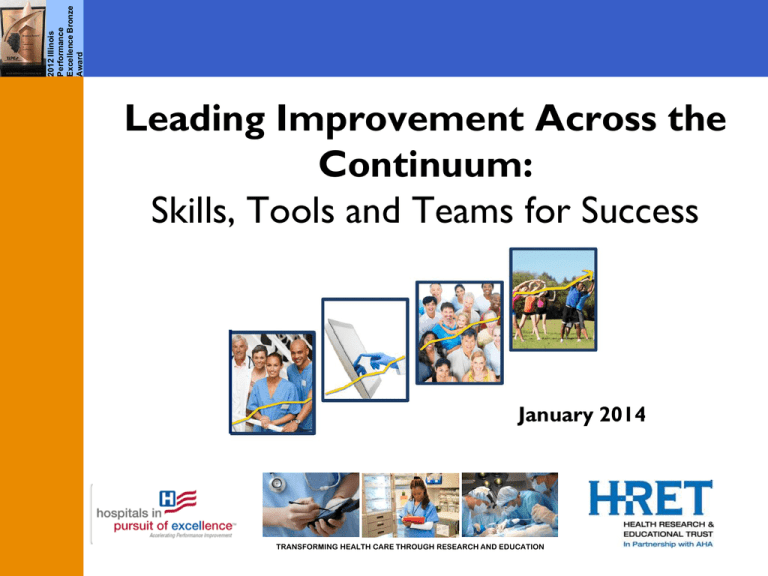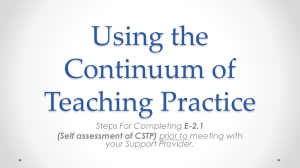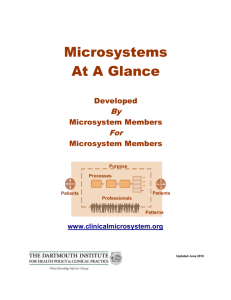
2012 Illinois
Performance
Excellence Bronze
Award
Leading Improvement Across the
Continuum:
Skills, Tools and Teams for Success
January 2014
TRANSFORMING HEALTH CARE THROUGH RESEARCH AND EDUCATION
Overview
Two new frameworks
• Improvement Continuum
• Leadership Action Model
Four levels
•
•
•
•
Topic/microsystem
Care coordination
Defined population
Community health
Lead improvement across the continuum
Sustain and spread
1
Two New Frameworks
Improvement Continuum
• Identifies four levels of improvement—
topic/microsystem, care coordination, defined population
and community health—and outlines the key skills, tools
and teams necessary for success at each level.
• These levels build upon one another.
Leadership Action Model
2
• Includes four steps to help leaders apply the
Improvement Continuum:
1. Identify a strategy.
2. Identify the skills, tools and teams necessary.
3. Plan to sustain the improvement.
4. Plan to spread the improvement.
Improvement Continuum
3
Topic/Microsystem
• Projects at the topic/microsystem level are implemented
in units or departments and address a specific challenge
that the unit has identified as an opportunity for
improvement.
• Teams need skills in both improvement science and
project management.
• Teams utilize project management tools, clinical
guidelines or checklists and improvement science tools.
(e.g., Lean, PDSA, Six Sigma).
• Teams include microsystem leaders, subject matter
leaders, a project manager and patients.
4
Topic/Microsystem
Examples:
• Reducing surgical site infections
• Reducing the percent of no-show appointments
• Reducing adverse drug events
• Increasing the efficient use of blood products
5
Care Coordination
• Projects at the care coordination level aim to address the
consequences of a highly fragmented care system.
• Care coordination requires skills in collaboration and
communication.
• Use of health information technology tools is critical.
• Teams should include leadership from multiple
microsystems and care navigators.
6
Care Coordination
Examples:
• Reducing transfers to the intensive care unit
• Reducing preventable emergency department visits
• Reducing preventable readmissions
7
Defined Population
• Improvement at the defined population level requires
building systems and processes to improve the health of a
distinct population of patients.
• Accountable care organizations are one model.
• Defined population improvement projects require skills in
data analytics.
• Risk stratification and risk prediction tools help to identify
high-risk, high-cost patients so that targeted interventions
can be implemented.
8
• Improvement teams at the defined population level should
add health information technology system analysts
and care managers to their teams.
Defined Population
Examples:
• Increasing appropriate discharge to hospice
• Increasing blood pressure control for hypertensive
patients
• Reducing emergency department visits for asthmatic
patients
• Increasing self-management of blood sugar control for
diabetic patients
9
Community Health
• Improvement projects at the community health level
leverage public health resources to improve health in a
geographically defined area.
• Partnership is the most important skill.
• Teams will need tools in epidemiology, health education
and public policy.
• Teams should include public health leaders, community
health workers and community organizations.
10
Community Health
Examples:
• Reduce obesity in the community
• Reduce prevalence of smoking in the community
• Reduce violence in the community
• Reduce disparities in health outcomes in the
community
11
Lead Improvement Across the Continuum
• The Improvement Continuum is a supplement to other
improvement science and project management tools.
• It is a framework to guide the development and
implementation of improvement projects.
• The Leadership Action Model shows how the
improvement continuum can be integrated into existing
improvement planning processes.
12
Leadership Action Model
13
Sustain and Spread
• Improvement projects should be designed to be sustained
beyond the grant, funding or PDSA cycle.
• Interventions must be built into the workflow so they are
not an added burden.
• Relationships, partnerships and teamwork are essential
for sustainability.
• Identify the key mechanisms and drivers of success for
the project.
• These processes, protocols and frameworks can then be
replicated in other environments to spread the
improvement.
14
Resources
•
•
•
•
15
Process Improvement Basics
• How to Improve
• Project Tracking Tool
Improvement Toolkits
• Comprehensive Unit-based Safety Program (CUSP) toolkit
• TeamSTEPPS
• Hospital Engagement Networks
• On the CUSP: Stop HAI
• Hospitals in Pursuit of Excellence
• Institute for Healthcare Improvement
Planning for Sustainability and Spread
• How-to Guide: Sustainability and Spread
• A Sustainable Planning Guide for Healthy Communities
• Planning for Scale: A Guide for Designing Large-Scale Improvement Initiatives
• A Framework for Spread: From Local Improvements to System-wide Change
• HRET Spread Assessment Tool
Community Health
• Creating a Culture of Health
• Collaboration Primer
For more information related to health care
delivery transformation, visit the
Hospitals in Pursuit of Excellence website at
www.hpoe.org.
16
Resources: For information related to behavioral and behavioral health, visit www.hpoe.org
and http://www.aha.org/psych
Accessible at: http://www.hpoe.org/improvement_continuum_october2013
Contact: hpoe@aha.org or (877) 243-0027
© 2013 American Hospital Association. All rights reserved. All materials contained in this
publication are available to anyone for download on www.hret.org or www.hpoe.org for
personal, noncommercial use only. No part of this publication may be reproduced and
distributed in any form without permission of the publisher, or in the case of third party
materials, the owner of that content, except in the case of brief quotations followed by the
above suggested citation. To request permission to reproduce any of these materials, please
email HPOE@aha.org.








